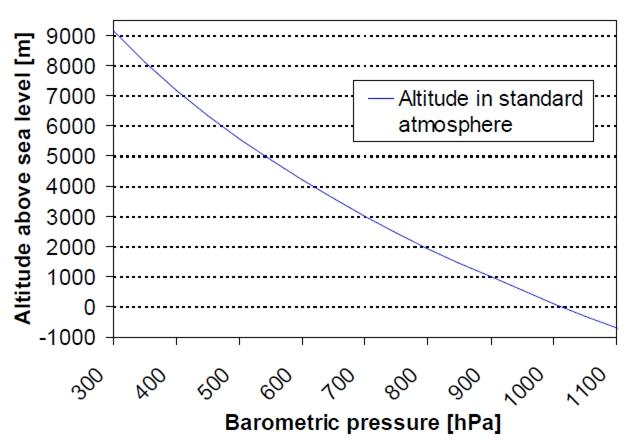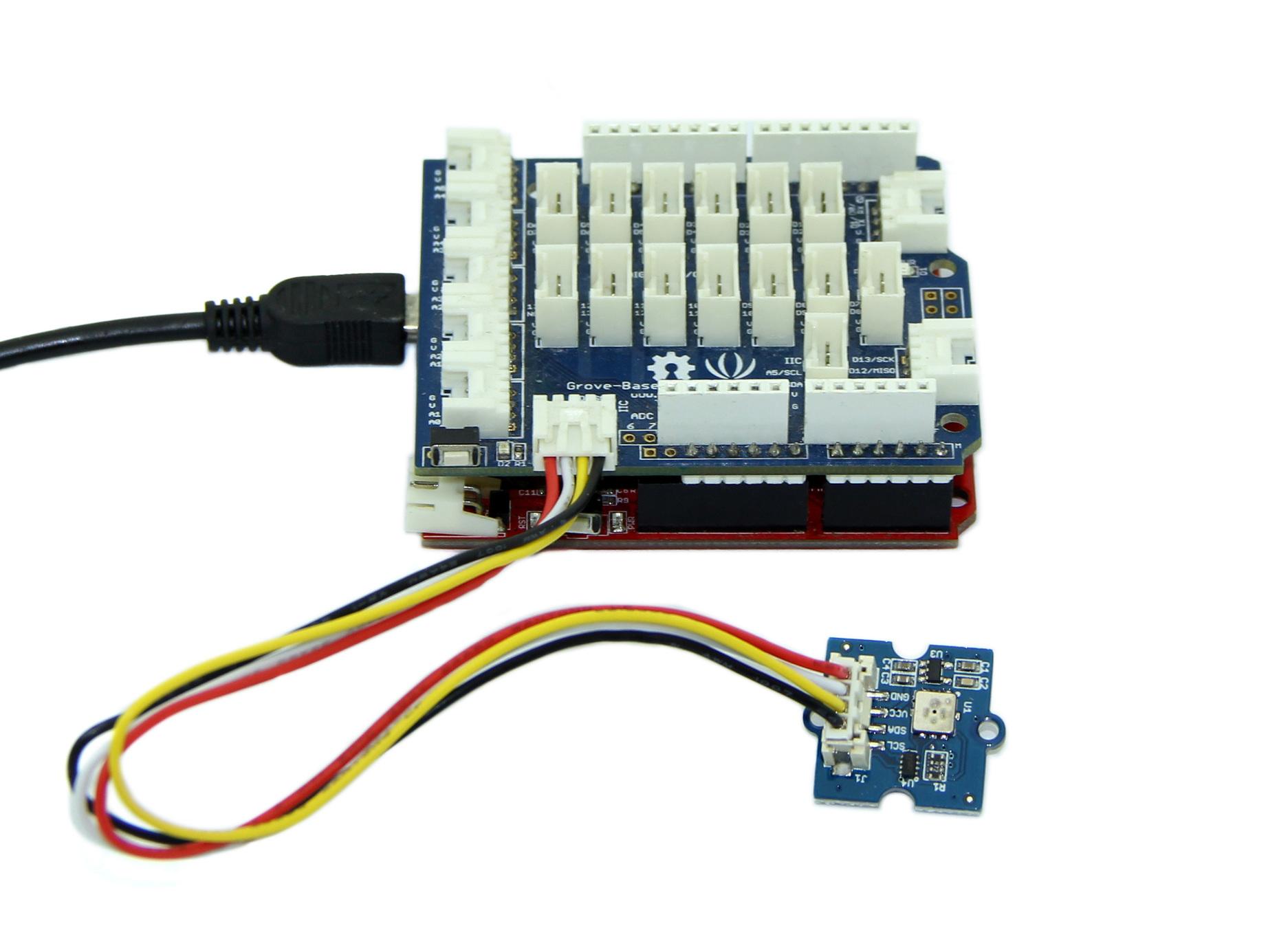Grove - Barometer (High-Accuracy)
Introduction

This Grove - Barometer (High-Accuracy) Sensor features a HP206C high-accuracy chip to detect barometric pressure ,Altimeter and temperature. It can widely measure pressure ranging from 300mbar~1200mbar, with a super high accuracy of 0.01mbar(0.1m) in ultra-high resolution mode.The chip only accepts 1.8V to 3.6V input voltage. However, with outer circuit added, this module becomes compatible with 3.3V and 5V. Therefore, it can be used on Arduino/Seeeduino or Seeeduino Stalker without modification.It is designed to be connected directly to a micro-controller via the I2C bus.
Features
- Digital two wire (I2C) interface
- Command-based Reading, Compensated (Optional)
- Programmable Events and Interrupt Controls
- Full Data Compensation
- Wide barometric pressure range
- Flexible supply voltage range
- Ultra-low power consumption
- Altitude Resolution down to 0.01 meter
- Temperature measurement included
Tip
More details about Grove modules please refer to Grove System
Application Ideas
- High Precision Mobile Altimeter / Barometer
- Industrial Pressure and Temperature Sensor System
- Automotive Systems
- Personal Electronics Altimetry
- Adventure and Sports watches
- Medical Gas Control System
- Weather Station Equipment
- Indoor Navigation and Map Assist
- Heating, Ventilation, Air Conditioning
Specifications
| Item | Min | Typical | Max | Unit |
|---|---|---|---|---|
| Voltage | 3.3 | 5 | 5.5 | VDC |
| Current | 635 | / | 1100 | uA |
| Pressure Range | 300 | / | 1200 | hPa |
| Faster I2C data transfer | / | / | 10 | MHz |
| Dimension | 20.4*41.8*9.7 | mm | ||
| Weight | / | g | ||
Platforms Supported
Usage
With Arduino
Barometric condition is one of the criteria used to predict coming change in weather and deduce altitude above sea level. Here is a demo to show you how to read the barometric data from this Grove - Barometer Sensor.
1.Connect it to I2C port of Seeeduino or Grove - Base Shield via a Grove cable. And connect Arduino to PC via a USB cable.
2.Download the library Grove_Barometer_HP20x;Unzip it into the libraries file of Arduino IDE by the path: ..\arduino-1.0.1\libraries.
3.Create a new Arduino sketch and paste the codes below to it or open the code directly by the path:File -> Example ->Barometer_Sensor->Barometer_Sensor.
/*
* Demo name ?: HP20x_dev demo
* Usage ?: I2C PRECISION BAROMETER AND ALTIMETER [HP206C hopeRF]
* Author ?: Oliver Wang from Seeed Studio
* Version ?: V0.1
* Change log ?: Add kalman filter 2014/04/04
*/
#include <HP20x_dev.h>
#include <KalmanFilter.h>
#include "Arduino.h"
#include "Wire.h"
unsigned char ret = 0;
/* Instance */
KalmanFilter t_filter; //temperature filter
KalmanFilter p_filter; //pressure filter
KalmanFilter a_filter; //altitude filter
void setup()
{
Serial.begin(9600); // start serial for output
Serial.println("****HP20x_dev demo by seeed studio****\n");
Serial.println("Calculation formula: H = [8.5(101325-P)]/100 \n");
/* Power up,delay 150ms,until voltage is stable */
delay(150);
/* Reset HP20x_dev */
HP20x.begin();
delay(100);
/* Determine HP20x_dev is available or not */
ret = HP20x.isAvailable();
if(OK_HP20X_DEV == ret)
{
Serial.println("HP20x_dev is available.\n");
}
else
{
Serial.println("HP20x_dev isn't available.\n");
}
}
void loop()
{
char display[40];
if(OK_HP20X_DEV == ret)
{
Serial.println("------------------\n");
long Temper = HP20x.ReadTemperature();
Serial.println("Temper:");
float t = Temper/100.0;
Serial.print(t);
Serial.println("C.\n");
Serial.println("Filter:");
Serial.print(t_filter.Filter(t));
Serial.println("C.\n");
long Pressure = HP20x.ReadPressure();
Serial.println("Pressure:");
t = Pressure/100.0;
Serial.print(t);
Serial.println("hPa.\n");
Serial.println("Filter:");
Serial.print(p_filter.Filter(t));
Serial.println("hPa\n");
long Altitude = HP20x.ReadAltitude();
Serial.println("Altitude:");
t = Altitude/100.0;
Serial.print(t);
Serial.println("m.\n");
Serial.println("Filter:");
Serial.print(a_filter.Filter(t));
Serial.println("m.\n");
Serial.println("------------------\n");
delay(1000);
}
}
4.Open the serial monitor to receive the sensor’s data including temperature, barometric pressure value, relative atmosphere pressure and altitude.

The following is a reference graph plotting out the relationship between altitude above sea level and barometric pressure.

Resources
- Grove_Barometer_High-Accuracy_v1.0_sch_pcb Eagle File
- HP206C Datasheet
- Github repository for Grove_Barometer_HP20x
| Arduino | Wio | BeagleBone | Raspberry Pi | LinkIt ONE |
|---|---|---|---|---|
 |
 |
 |
 |
 |
Caution
The platforms mentioned above as supported is/are an indication of the module's hardware or theoritical compatibility. We only provide software library or code examples for Arduino platform in most cases. It is not possible to provide software library / demo code for all possible MCU platforms. Hence, users have to write their own software library.
Help us make it better
Welcome to the new documentation system of Seeed Studio. We have made a lot of progress comparing to the old wiki system and will continue to improve it to make it more user friendly and helpful. The improvement can't be done without your kindly feedback. If you have any suggestions or findings, you are most welcome to submit the amended version as our contributor via Github or give us suggestions in the survey below, it would be more appreciated if you could leave your email so that we can reply to you. Happy Hacking!


